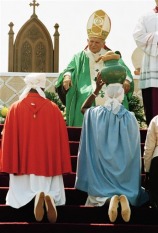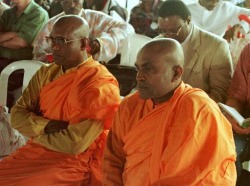Zimbabwe: Religion
Jenna Wohlfert
World History- Hjelmgren
5.18.09
Zimbabwe Religion
Religion plays an important role in Zimbabwe culture. There are many different indigenous beliefs, the most common is Shona, and 25% of the population is Christian.
Christianity did not come easily into Zimbabwe. The Portuguese attempted to begin Christianity in Zimbabwe in 1561 but was not successful. Christianity was reintroduced in 1859 by European Reverend Robert Moffat. In the 1970s the church established the catholic commissions for justice and peace to monitor human rights violations and promote social justice.
Shona is a religion where the believers believe in Mwari, the god, witchcraft, and spirits. The Shona are monotheistic and believe that Mwari is the original ancestor, not the creator of Earth. The people worship Mwari in caves and sacred mountains; the most important shrine is Matonjeni. Mwari is inaccessible to humans, but delegated great spirits to provide the people with rainfall and crops. The Mambo King was regarded as a god, and his word came directly from Mwari. He had to be flawless in order to stay in power; if he became ill, he had to commit suicide, he had to rely on his officials, courtiers, and queens.
The Shona spirits are extremely important to the religion. The Mhondoro are spirit protectors of the community and each clan has their own Mhondoro. When they are happy there is good rain and plenty of food, but when they are mad, there is disease and drought. Another kind of spirit is the Vadzimu who are the primary contacts for humans to the living dead; they are the “spirit elders”. They are identified with particular families and pay close attention to the family members’ lives. The family members turn to the Vadzimu in times of difficulty for help. The way the family communicates with the Vadzimu is through the Svikiro, who is a medium possessed by a Mhondoro or Vadzimu. The Svikiro is like any normal person in the tribe. However, they have to avoid certain western things and wear white attire with a ceremonial staff. They can sometimes exert powerful influences on people. The Ngozi is another kind of spirit, one who is restless and vengeful. There are four different types of Ngozi: someone who was murdered; a servant not paid, or someone who had something stolen; a husband or wife unhappy with their spouse; a parent wronged by their child(ren). The offender has to pay a required fee to repay for what they did through a bira (below). A Shave is also a vengeful spirit, but is the spirit of a dead stranger who was killed unjustly or denied proper burial. The Shave possesses someone which causes the person to become ill.
Everything in the Shona religion is connected in some way and even the good things people can be bad.The N’anga is a traditional healer, but also exorcises evil spirits. “N’anga are able to consult spirits through the use of divining dice, the Shona wooden bones, animal bones, or mungomo ( seeds popular among the Ndebele), and are versed in the knowledge of medicinal herbs…” (Culture and Customs of Zimbabwe.) A Chiremba is an herbal doctor, they do not practice in evil spirits like the N’anga do. The N’anga take vengeful spirits and trap them in bottles or animals, then leave the bottle or animal for unsuspecting people to stumble upon. Then there are witches, who are frequent suspects of young or sudden deaths. There are two kinds of witches; witches who acquired the trait and those who inherit it. Witches are believed to send malevolent spirits to attack rich people.
A bira is the most important event in Shona religion; it is also called an Mbira. It is an all night event in which possession is the main object. Possession is a very important aspect in Shona religion. A bira is “an all-night ceremony during which family members assemble to seek help from a common ancestor through a medium.” (Culture and Customs of Zimbabwe.) Music induces the medium into becoming the spirit that possessed them. The ceremony first starts off with the family members segregated the men from the women and children with the mediums sitting on mats facing the musician. They then drink a special beer and tell the mediums their problems that caused the family to arrange the bira. The medium then listens to the music that induces them and becomes the exclusive “mount” of one spirit. A bira takes place in specially built buildings used in religious occasions only. “The bira enables them to ask the latter for intercession with deity. “(Culture and Customs of Zimbabwe.)
Through out the many years that Christianity and Shona have been around, there has been conflict mainly around witchcraft. Even though the religions are very different, there are many people who have combined the two traditions. “It is not unusual to hear African Christians refer to Jesus as universal mudzimu.” (Culture and Customs of Zimbabwe.).
World History- Hjelmgren
5.18.09
Zimbabwe Religion
Religion plays an important role in Zimbabwe culture. There are many different indigenous beliefs, the most common is Shona, and 25% of the population is Christian.
Christianity did not come easily into Zimbabwe. The Portuguese attempted to begin Christianity in Zimbabwe in 1561 but was not successful. Christianity was reintroduced in 1859 by European Reverend Robert Moffat. In the 1970s the church established the catholic commissions for justice and peace to monitor human rights violations and promote social justice.
Shona is a religion where the believers believe in Mwari, the god, witchcraft, and spirits. The Shona are monotheistic and believe that Mwari is the original ancestor, not the creator of Earth. The people worship Mwari in caves and sacred mountains; the most important shrine is Matonjeni. Mwari is inaccessible to humans, but delegated great spirits to provide the people with rainfall and crops. The Mambo King was regarded as a god, and his word came directly from Mwari. He had to be flawless in order to stay in power; if he became ill, he had to commit suicide, he had to rely on his officials, courtiers, and queens.
The Shona spirits are extremely important to the religion. The Mhondoro are spirit protectors of the community and each clan has their own Mhondoro. When they are happy there is good rain and plenty of food, but when they are mad, there is disease and drought. Another kind of spirit is the Vadzimu who are the primary contacts for humans to the living dead; they are the “spirit elders”. They are identified with particular families and pay close attention to the family members’ lives. The family members turn to the Vadzimu in times of difficulty for help. The way the family communicates with the Vadzimu is through the Svikiro, who is a medium possessed by a Mhondoro or Vadzimu. The Svikiro is like any normal person in the tribe. However, they have to avoid certain western things and wear white attire with a ceremonial staff. They can sometimes exert powerful influences on people. The Ngozi is another kind of spirit, one who is restless and vengeful. There are four different types of Ngozi: someone who was murdered; a servant not paid, or someone who had something stolen; a husband or wife unhappy with their spouse; a parent wronged by their child(ren). The offender has to pay a required fee to repay for what they did through a bira (below). A Shave is also a vengeful spirit, but is the spirit of a dead stranger who was killed unjustly or denied proper burial. The Shave possesses someone which causes the person to become ill.
Everything in the Shona religion is connected in some way and even the good things people can be bad.The N’anga is a traditional healer, but also exorcises evil spirits. “N’anga are able to consult spirits through the use of divining dice, the Shona wooden bones, animal bones, or mungomo ( seeds popular among the Ndebele), and are versed in the knowledge of medicinal herbs…” (Culture and Customs of Zimbabwe.) A Chiremba is an herbal doctor, they do not practice in evil spirits like the N’anga do. The N’anga take vengeful spirits and trap them in bottles or animals, then leave the bottle or animal for unsuspecting people to stumble upon. Then there are witches, who are frequent suspects of young or sudden deaths. There are two kinds of witches; witches who acquired the trait and those who inherit it. Witches are believed to send malevolent spirits to attack rich people.
A bira is the most important event in Shona religion; it is also called an Mbira. It is an all night event in which possession is the main object. Possession is a very important aspect in Shona religion. A bira is “an all-night ceremony during which family members assemble to seek help from a common ancestor through a medium.” (Culture and Customs of Zimbabwe.) Music induces the medium into becoming the spirit that possessed them. The ceremony first starts off with the family members segregated the men from the women and children with the mediums sitting on mats facing the musician. They then drink a special beer and tell the mediums their problems that caused the family to arrange the bira. The medium then listens to the music that induces them and becomes the exclusive “mount” of one spirit. A bira takes place in specially built buildings used in religious occasions only. “The bira enables them to ask the latter for intercession with deity. “(Culture and Customs of Zimbabwe.)
Through out the many years that Christianity and Shona have been around, there has been conflict mainly around witchcraft. Even though the religions are very different, there are many people who have combined the two traditions. “It is not unusual to hear African Christians refer to Jesus as universal mudzimu.” (Culture and Customs of Zimbabwe.).
Bibliography
Owomolyela, Oyekan. “Thought and Religion.” Culture and Customs of
Zimbabwe. London: Greenwood Press, 2002. 27-41.
This book is about Zimbabwe and this chapter was all about the religion in Zimbabwe and the most important indigenous religion Shona.
"Shona Religion and Expressive Culture." World Culture Encyclopedia. 17 May
2009. <http://www.everyculture.com/Africa-Middle-East/
Shona-Religion-and-Expressive-Culture.html>.
This website is all about the aspects of Zimbabwe religion. There is information about; religious beliefs, religious practitioners, ceremonies, arts, medicine, death and afterlife.
Shona Religion and Beliefs. 17 May 2009 <http://www.zambuko.com/mbirapage/
resource_guide/pages/culture/shona_religion.html>.
This website has information on death and dying in Shona culture, kurova dura or bira, and Ndebele customs and traditions.
Last Updated by Jenna Wohlfert 9:04 a.m. Friday, May 22, 2009


